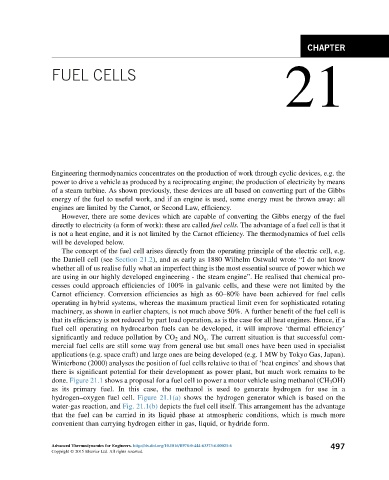Page 504 - Advanced thermodynamics for engineers
P. 504
CHAPTER
21
FUEL CELLS
Engineering thermodynamics concentrates on the production of work through cyclic devices, e.g. the
power to drive a vehicle as produced by a reciprocating engine; the production of electricity by means
of a steam turbine. As shown previously, these devices are all based on converting part of the Gibbs
energy of the fuel to useful work, and if an engine is used, some energy must be thrown away: all
engines are limited by the Carnot, or Second Law, efficiency.
However, there are some devices which are capable of converting the Gibbs energy of the fuel
directly to electricity (a form of work): these are called fuel cells. The advantage of a fuel cell is that it
is not a heat engine, and it is not limited by the Carnot efficiency. The thermodynamics of fuel cells
will be developed below.
The concept of the fuel cell arises directly from the operating principle of the electric cell, e.g.
the Daniell cell (see Section 21.2), and as early as 1880 Wilhelm Ostwald wrote “I do not know
whether all of us realise fully what an imperfect thing is the most essential source of power which we
are using in our highly developed engineering - the steam engine”. He realised that chemical pro-
cesses could approach efficiencies of 100% in galvanic cells, and these were not limited by the
Carnot efficiency. Conversion efficiencies as high as 60–80% have been achieved for fuel cells
operating in hybrid systems, whereas the maximum practical limit even for sophisticated rotating
machinery, as shown in earlier chapters, is not much above 50%. A further benefit of the fuel cell is
that its efficiency is not reduced by part load operation, as is the case for all heat engines. Hence, if a
fuel cell operating on hydrocarbon fuels can be developed, it will improve ‘thermal efficiency’
significantly and reduce pollution by CO 2 and NO x . The current situation is that successful com-
mercial fuel cells are still some way from general use but small ones have been used in specialist
applications (e.g. space craft) and large ones are being developed (e.g. 1 MW by Tokyo Gas, Japan).
Winterbone (2000) analyses the position of fuel cells relative to that of ‘heat engines’ and shows that
there is significant potential for their development as power plant, but much work remains to be
done. Figure 21.1 shows a proposal for a fuel cell to power a motor vehicle using methanol (CH 3 OH)
as its primary fuel. In this case, the methanol is used to generate hydrogen for use in a
hydrogen–oxygen fuel cell. Figure 21.1(a) shows the hydrogen generator which is based on the
water-gas reaction, and Fig. 21.1(b) depicts the fuel cell itself. This arrangement has the advantage
that the fuel can be carried in its liquid phase at atmospheric conditions, which is much more
convenient than carrying hydrogen either in gas, liquid, or hydride form.
Advanced Thermodynamics for Engineers. http://dx.doi.org/10.1016/B978-0-444-63373-6.00021-6 497
Copyright © 2015 Elsevier Ltd. All rights reserved.

